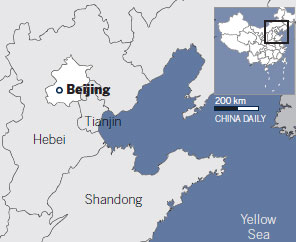Red tourism offers up revolutionary attractions
Updated: 2014-06-27 07:07
By Zheng Xin (China Daily)
|
|||||||||||
Tourism authorities in Beijing, Tianjin and Hebei province have designated 10 Red tourism routes to promote historical sites that played a significant role in the country's revolution in the early 20th century.
People can re-trace the footprints of Chinese revolutionaries while traveling along the routes and visiting must-see sites like the former base of the Central Committee of the Communist Party of China in Xibaipo in Shijiazhuang and former headquarters of the Jinchaji military command in Baoding, Hebei province.
The Beijing-Tianjin-Hebei region is rich in tourism resources, and many scenic spots in the region proudly echo the glory of China's revolutionary history, says Song Yu, deputy head of the Beijing tourism development committee.
"The tourism authorities in the three regions should complement each other's advantages and further boost the country's ever-growing domestic tourism," he says.

Song says tourism authorities plan to further integrate resources and come up with more tour routes, particularly self-driving tours and road trips, while providing more trains to facilitate visitors.
Officials from Beijing, Tianjin and Hebei province are working on a joint development plan with the aim of improving the region's overall competitiveness, the integration of which is expected to give the region a powerful boost.
The cooperation will bring about tremendous economic progress in northern China, says Cao Heping, an economist from Peking University.
A retired staff member from the Beijing-based Central Studio of News Reels Production - the main production base of Chinese news and documentary movies founded in 1953 - who introduced himself as Feng, says he was considering going to visit the former site of North China Film Team, the predecessor of the studio, together with his old colleagues.
"Not everybody knows the studio takes its roots from Shijiazhuang in Hebei province," he says. "It will be exciting to go in pursuit of the former glory and refulgence."
According to Yang Jinsong, a professor at the China Tourism Academy in Beijing, regional cooperation plays a key role in boosting tourism.
Yang suggests a coordination committee, run by the National Development and Reform Commission, to coordinate regional tourism development and further improve its road construction and communication infrastructure.
Yang notes that besides improving roads and other infrastructure, improving the air quality - especially in Hebei province - is essential to attract more tourists from home and abroad.
Yang Shihao, deputy head of Tianjin's tourism authority, says that compared with the capital, Tianjin and Hebei still lag behind in popularity, and this requires more efforts to attract more domestic tourists.
AT A GLANCE
Major historical spots included in the Red tourism routes:
��Chairman Mao Zedong Memorial Hall in Beijing.
��Cemetery of martyrs who died in the War of Resistance against Japanese Aggression (1937-45) in Shidu, Beijing.
��Former site of the Central Committee of the Communist Party of China at the Xibaipo Scenic Spot in Shijiazhuang, Hebei province.
��Former headquarters of the Jinchaji military command in Baoding, Hebei province.
��Memorial Hall dedicated to Dwarkanath Kotnis and Norman Bethune, who are widely known by Chinese people for their contribution in the War of Resistance against Japanese Aggression, in Shijiazhuang, Hebei province.
��Baiyangdian Lake, the largest natural freshwater lake in northern China and a significant battlefield area during the war, in Baoding, Hebei province.
��The memorial to Zhou Enlai and Deng Yingchao in Tianjin.
��Panshan Cemetery of Martyrs in Tianjin.
zhengxin@chinadaily.com.cn
(China Daily 06/27/2014 page18)
Today's Top News
China, Germany join hands to drive growth
Meet foreigner breed of workers
Product placement deal backfires
From Westlife to the East
Gambling costs World Cup fans their lives
US supports Ukraine's decision to suspend ceasefire
It's all about making a spectacle
China likely to see 7.5% growth in second quarter
Hot Topics
Lunar probe , China growth forecasts, Emission rules get tougher, China seen through 'colored lens', International board,
Editor's Picks

|

|

|

|

|

|





